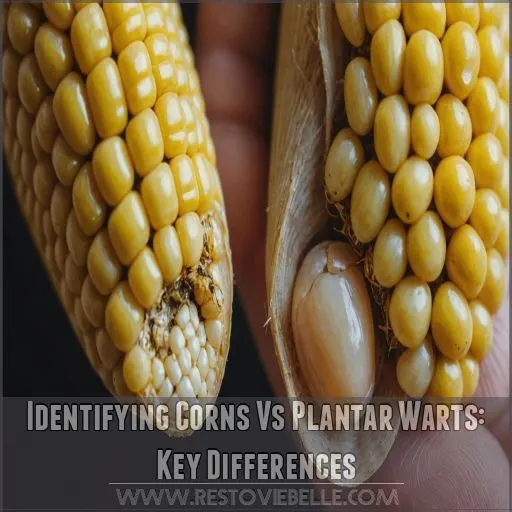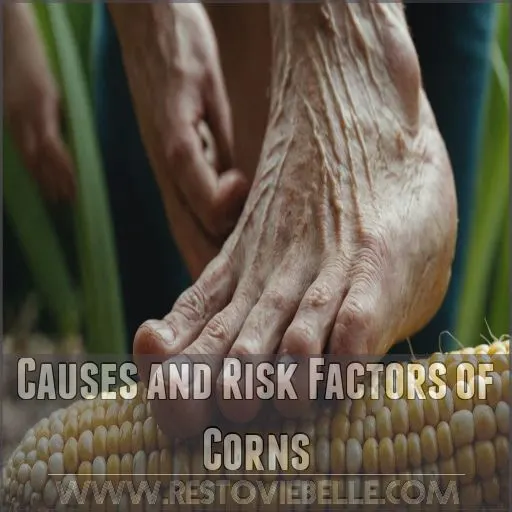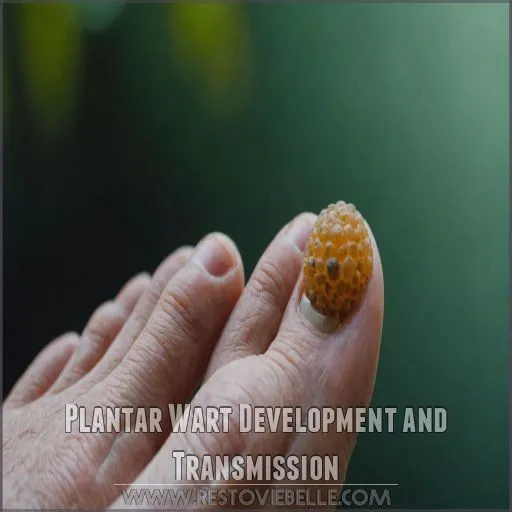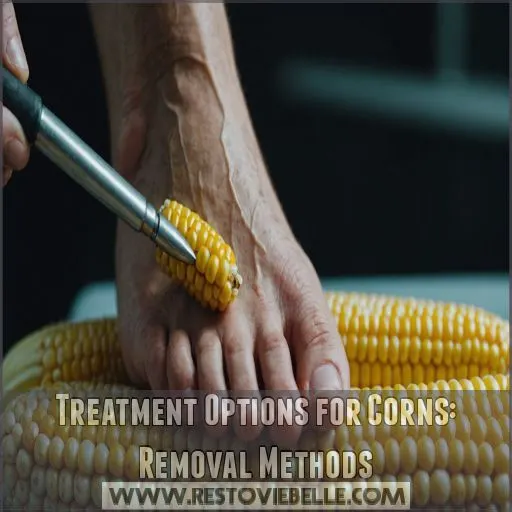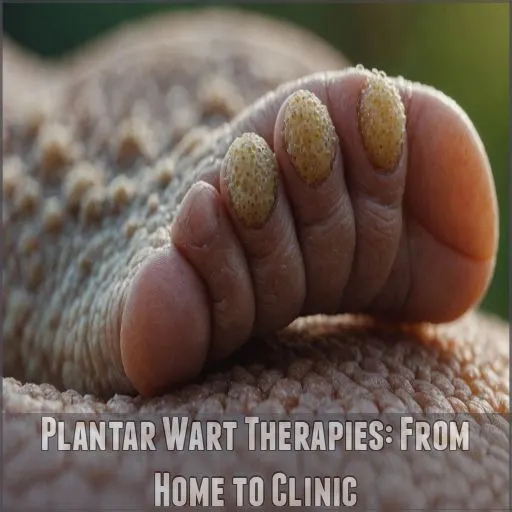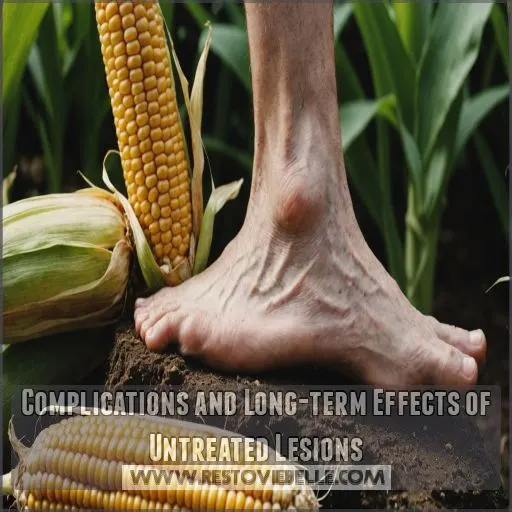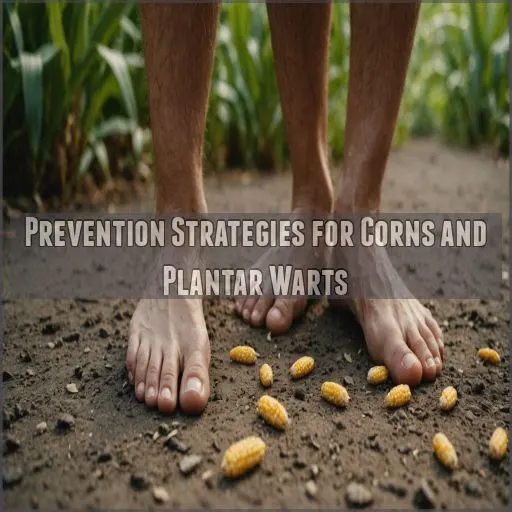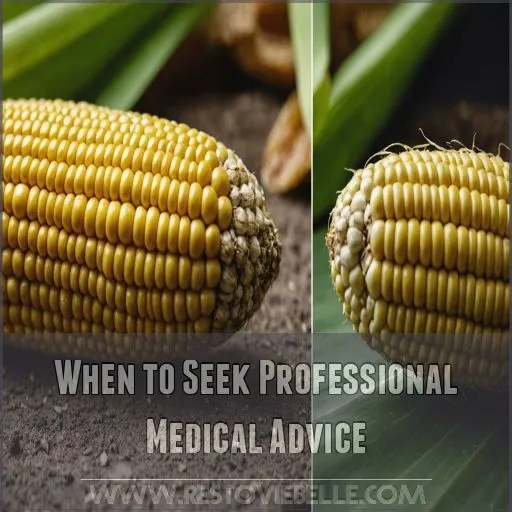This site is supported by our readers. We may earn a commission, at no cost to you, if you purchase through links.

Corns are like nature’s shoe cushions gone wrong – hard, raised bumps caused by friction. They typically crash on your toes.
Plantar warts, on the other hand, are flat, fleshy party crashers courtesy of the HPV virus. They prefer the soles of your feet.
The big difference? Corns won’t spread, but plantar warts love to mingle. Both can be a pain in the foot, but knowing which one you’re dealing with is key to giving it the boot – it’s key to giving it the boot.
Stick around to uncover some surprising facts about these foot foes!
Table Of Contents
- Key Takeaways
- Identifying Corns Vs Plantar Warts: Key Differences
- Causes and Risk Factors of Corns
- Plantar Wart Development and Transmission
- Diagnostic Techniques for Corns and Plantar Warts
- Treatment Options for Corns: Removal Methods
- Plantar Wart Therapies: From Home to Clinic
- Complications and Long-term Effects of Untreated Lesions
- Prevention Strategies for Corns and Plantar Warts
- When to Seek Professional Medical Advice
- Emerging Research in Corn and Plantar Wart Management
- Frequently Asked Questions (FAQs)
- What is the difference between a wart and a corn?
- How are plantar warts different from other warts?
- Is a plantar wart the same as a callus?
- How do I know if I have a plantar wart or a corn?
- Will corn remover work on plantar warts?
- How do you remove a plantar corn?
- Do corns have a hole in the middle?
- Can corns or plantar warts affect foot biomechanics?
- Are there any dietary factors influencing corn or wart development?
- How do pregnancy and hormonal changes impact these conditions?
- Can corns or plantar warts recur after successful treatment?
- Do genetics play a role in susceptibility to corns or warts?
- Conclusion
Key Takeaways
- You can spot the difference: Corns are like nature’s shoe cushions gone wrong – hard, raised bumps on your toes. Plantar warts, on the other hand, are flat, fleshy party crashers on your soles with tiny black dots.
- Location, location, location: Corns tend to appear on your toes, while plantar warts prefer the soles of your feet. It’s like they’ve got their own real estate preferences!
- Spread the news (or don’t): Corns keep to themselves, but plantar warts are social butterflies – they can spread to other parts of your body or even to other people. Talk about overstaying their welcome!
- Don’t ignore them: Both corns and plantar warts can disrupt your walking style if left untreated. They might start small, but they can lead to bigger issues down the road. It’s best to address them before they become a real pain in the foot!
Identifying Corns Vs Plantar Warts: Key Differences
You might think all foot bumps are created equal, but corns and plantar warts are worlds apart.
Knowing the key differences between these pesky foot problems can save you from misdiagnosis and help you get the right treatment faster.
Visual Appearance and Texture
You might think all foot bumps look the same, but corns and plantar warts have some eye-opening differences!
Corns are small, raised bumps with a hard center surrounded by softer, swollen skin.
Plantar warts, on the other hand, often resemble flat, fleshy, and grainy growths (Source).
plantar warts sometimes have tiny black dots in their center, like seeds in a fruit, which can be a key distinguishing feature!
Location on the Foot
Location is key when it comes to telling these pesky foot problems apart. Your feet are like a map, with different spots prone to specific issues.
- Corns: Top performers on toes and sides of feet
- Plantar warts: Sole survivors on heels and balls of feet
- Calluses: Supporting actors on heels, balls, and outer edges
- Between-toe territory: Soft corns’ favorite hangout
Causes and Development
Now that we’ve pinpointed where these pesky foot troubles appear, let’s uncover what causes them. Corns and plantar warts might look similar, but they’re as different as apples and oranges in terms of their origins.
| Feature | Corns | Plantar Warts |
|---|---|---|
| Culprit | Friction & Pressure | HPV Virus |
| Trigger | Ill-fitting shoes | Skin breaks |
| Development | Gradual thickening | Viral growth |
Corns form when your feet cry "uncle" from constant rubbing, while plantar warts are uninvited guests, courtesy of the HPV virus.
Contagiousness and Spread
While corns are harmless skin thickenings, plantar warts are the party crashers of foot problems. These pesky growths are caused by the human papillomavirus (HPV), which loves to spread its wings.
Warts are social butterflies that can hop from person to person through:
- Direct skin-to-skin contact
- Shared towels or shoes
- Walking barefoot in public areas
- Touching your own warts and then other body parts
Remember, a strong immune system is your best bouncer against these uninvited guests.
Pain and Discomfort Levels
Pain can be a real game-changer with corns and plantar warts.
Let’s break down the discomfort levels:
| Aspect | Corns | Plantar Warts |
|---|---|---|
| Pain Type | Dull, constant | Sharp, pinpoint |
| Walking Impact | Moderate | Severe |
| Pressure Sensitivity | High | Extreme |
| Pain Duration | Continuous | Intermittent |
| Treatment Relief | Quick | Gradual |
You’ll find corns typically cause a persistent ache, while plantar warts can make you feel like you’re walking on a pebble. Ouch!
Associated Symptoms
While corns often bring a dull ache, plantar warts can feel like you’re walking on pebbles.
You might notice inflammation around corns, but warts can surprise you with tiny black dots – their "seeds".
Itching? That’s more common with warts. And if you spot bleeding, it’s time to give your feet some TLC, and observe tiny black dots.
Causes and Risk Factors of Corns
You might be surprised to learn that those pesky corns on your feet aren’t just a fashion faux pas.
From ill-fitting shoes to foot deformities, there are several sneaky culprits behind these stubborn skin thickenings that can make every step a painful adventure.
Ill-fitting Shoes and Excessive Pressure
Squeezing into ill-fitting shoes isn’t just a fashion faux pas—it’s a recipe for corn catastrophe. Your feet bear the brunt when shoes don’t fit right, leading to painful pressure points and friction.
- Pinched toes crying out for space
- Heels rubbing raw with every step
- Balls of your feet screaming for mercy
- Arches aching from lack of support
Don’t let your shoes be the villains in your foot health story. Proper fit is key to keeping corns at bay.
Foot Deformities and Structural Issues
Your feet’s unique shape can be a real troublemaker with corns.
Structural issues like bunions, hammertoes, or even high arches aren’t just quirky features – they’re corn magnets!
These deformities create pressure points where your skin rubs against shoes, leading to those pesky corns.
It’s like your feet are playing a game of "pin the corn on the foot," and unfortunately, they’re winning!
Repetitive Activities and Friction
Repetitive activities and friction are like sandpaper for your feet! Whether you’re a marathon runner or a desk jockey, your daily grind can lead to pesky corns.
Let’s break it down:
- Footwear faux pas: Ill-fitting shoes are corn’s best friends
- Barefoot blunders: Going sockless invites friction
- Occupational hazards: Standing or walking for hours can create pressure points
Remember, your feet aren’t punching bags! Treat them right, and they’ll keep you dancing through life.
Age-related Changes in Foot Structure
As the years roll by, your feet don’t just get older – they change shape!
Foot arches may flatten, toes might develop a mind of their own, and heel spurs could make an unwelcome appearance.
These age-related changes can throw your shoe fit off balance, increasing pressure on certain spots.
It’s like your feet are playing a game of musical chairs, but instead of fun, you get corns!
Occupational Hazards
Certain jobs can be a real pain in the… foot! If you’re on your feet all day or using hand tools without proper protection, you’re at higher risk for developing corns.
Think about it: construction workers, hairdressers, and even musicians can all fall victim to these pesky bumps.
But don’t worry! With the right footwear, safety gear, and ergonomic adjustments, you can keep your feet happy and corn-free.
Plantar Wart Development and Transmission
You might think that bump on your foot is just a harmless corn, but it could be a sneaky plantar wart in disguise.
Let’s uncover how these pesky warts develop and spread, so you can protect your feet from becoming their next unwitting host, and get to the bottom of these pesky warts.
Human Papillomavirus (HPV) Infection
The culprit behind your pesky plantar warts? It’s none other than the Human Papillomavirus (HPV).
But don’t worry, it’s not the same type that causes those other embarrassing warts .
HPV types 1, 2, 3, 4, 27, and 57 are the usual suspects for plantar warts .
These sneaky viruses love to hang out in warm, moist environments, waiting for the perfect moment to make your feet their new home.
Entry Points and Skin Breaks
You might think your feet are tough, but they’re more vulnerable than you realize.
Plantar warts sneak in through tiny breaks in your skin, turning your soles into their personal playground.
- Skin abrasions from rough surfaces
- Minor cuts from sharp objects
- Open wounds from athlete’s foot
Don’t let these sneaky entry points catch you off guard! Keep your feet protected, especially in public areas where the virus lurks.
Incubation Period and Growth
Ever wonder how long it takes for a plantar wart to make its debut?
Unlike corns, which develop from friction, plantar warts have a sneaky incubation period.
After HPV finds a cozy home in your skin, it can take up to twelve months for the wart to show its face.
Talk about playing the long game!
Once it appears, though, that little bugger can grow faster than you’d think.
[BOLD: plantar wart, incubation period, HPV]
Environmental Factors Promoting Transmission
Four key environmental factors can turn your average day into a plantar wart nightmare.
Public pools and shared showers are hotspots for these viral hitchhikers . Warm, damp climates create a cozy home for the human papillomavirus (HPV) that causes warts.
Don’t let your guard down on seemingly innocent surfaces – those moist locker room floors are teeming with trouble. And remember, skin-to-skin contact is like rolling out the red carpet for HPV transmission.
Immune System Role in Susceptibility
In light of your immune system‘s role, susceptibility to plantar warts isn’t just about where you walk barefoot. Your body’s defense mechanisms play a key part in whether you’ll develop these pesky viral growths.
- Stress levels impacting immune function
- Nutritional status supporting immune health
- Sleep quality influencing immune response
- Chronic conditions weakening immunity
- Medications potentially suppressing immune defenses
Remember, a robust immune system is your best defense against HPV-caused plantar warts!
Diagnostic Techniques for Corns and Plantar Warts
You might think you’ve got a corn, but surprise!
It could be a plantar wart in disguise.
Let’s uncover the sneaky differences between these foot fiends and explore the clever detective work doctors use to crack the case.
Visual Examination and Palpation
When you’re playing detective with your feet, visual examination and palpation are your trusty sidekicks.
You’ll want to channel your inner Sherlock Holmes as you scan for clues.
Look closely at the bump’s appearance and feel its texture.
Is it grainy with black dots? You might be dealing with a plantar wart.
If it’s a small, raised bump with a hard center, you’ve likely stumbled upon a corn.
Dermoscopy for Plantar Warts
You’ve probably heard of dermoscopy, but did you know it’s a game-changer for plantar wart diagnosis? This non-invasive technique lets your doctor peek beneath the skin’s surface without any cutting.
- Tiny black dots (thrombosed capillaries)
- Yellow-gray structureless areas
- Irregular red dots or lines
- Whitish halos around vessels
- Disrupted skin lines
Dermoscopy can help distinguish warts from corns, making your diagnosis more accurate and treatment more targeted.
Skin Scraping and Biopsy
Dermoscopy’s great, but sometimes you need to dig deeper.
Enter skin scraping and biopsy – the dynamic duo of diagnosis! Your doctor will gently pare the lesion without drawing blood, using a scalpel . It’s like peeling an onion, revealing the true nature of your foot foe.
This procedure helps distinguish between corns and warts, ensuring you get the right treatment.
Don’t worry, it’s quick and relatively painless. The overall goal is to get the right diagnosis to guide the correct treatment plan.
Imaging Studies for Underlying Issues
Sometimes, your feet need a closer look to uncover what’s really going on. Imaging studies can reveal the hidden culprits behind your corns or plantar warts.
X-rays might show:
- Sneaky bone spurs playing hide-and-seek
- Foot bones doing the twist (deformities)
- Nerves caught in a tight squeeze
These underlying issues could be the real troublemakers, turning your tootsies into a battlefield. By peeking under the hood, so to speak, doctors can craft a treatment plan that’s right on the money.
Differential Diagnosis Considerations
After looking at your foot, your doctor’s detective work isn’t over. They’ll consider other possible culprits that might be masquerading as corns or warts.
Let’s break down the differential diagnosis process:
| Condition | Key Features | Diagnostic Clue |
|---|---|---|
| Corn | Hard, raised | Painful to press |
| Plantar Wart | Tiny dots inside | Hurts when squeezed |
| Callus | Larger, flatter | No distinct core |
Remember, even seasoned pros sometimes need a closer look. A skin biopsy might be the ace up their sleeve for tricky cases.
Treatment Options for Corns: Removal Methods
You’ve got a corn that’s causing you grief.
But don’t worry – there are plenty of ways to kick it to the curb.
From over-the-counter remedies to professional treatments, let’s explore your options for bidding farewell to that pesky corn once and for all.
Over-the-counter Corn Pads and Medications
Tackling corns with over-the-counter solutions? You’re not alone!
From cushiony corn wraps to medicated pads, there’s a buffet of options at your local drugstore.
But tread carefully – some products pack a punch with salicylic acid, which can be too harsh for sensitive skin.
For a gentler approach, try non-medicated pads or moisturizers to soften the skin and ease discomfort.
Patience is key in this corn-busting journey!
Professional Debridement Techniques
Professional debridement isn’t just a fancy term for corn removal – it’s your ticket to happy, pain-free feet. A podiatrist will skillfully pare back that stubborn hard skin using specialized tools, giving you instant relief.
They’ll also educate you on prevention and assess your walking style to address the root cause.
Don’t worry, it’s typically painless and more effective than shrinking pores naturally DIY methods
.
Custom Orthotics and Shoe Modifications
Custom orthotics and shoe modifications can be game-changers for your corn-battling journey. These tailor-made solutions address the root cause of your pesky corns by redistributing pressure and providing much-needed support.
- Correct biomechanical issues
- Provide targeted arch support
- Reduce friction in problem areas
You’ll feel like you’re walking on clouds with these personalized foot heroes. Remember, the right fit can make all the difference between hobbling and happily hoofing it through your day!
Surgical Intervention for Severe Cases
When orthotics and shoe changes don’t cut it, surgical intervention might be your ticket to corn-free feet.
It’s not a decision to take lightly, though. Your podiatrist will weigh the pros and cons, considering factors like surgical risks and recovery time.
Corn removal surgery can take 6 weeks to 3 months for full recovery, depending on the extent of the procedure (Source). It’s a last resort, but for severe cases, it might be your path to happy feet.
Lifestyle Changes to Prevent Recurrence
After surgery, you’re not out of the woods yet. To keep those pesky corns from making a comeback, it’s time to shake up your lifestyle.
- Embrace the sneaker life: Ditch those tight shoes and opt for comfy kicks
- Pamper your feet: Give them a daily ice and stretch session
- Swap high-impact for low: Trade running for swimming or walking
- Maintain a healthy weight: Less pressure means happier feet
Plantar Wart Therapies: From Home to Clinic
Plantar warts can be a real pain in the foot, but don’t worry – there’s a whole arsenal of treatments at your disposal.
From at-home remedies to high-tech clinic procedures, you’ve got options that’ll have those pesky warts waving the white flag in no time, with a whole arsenal of treatments.
Salicylic Acid Treatments
Salicylic acid is your go-to warrior in the battle against plantar warts. This over-the-counter treatment packs a punch, slowly but surely peeling away those pesky viral invaders.
| Strength | Application | Duration |
|---|---|---|
| 17% | Daily | 4-6 weeks |
| 40% | Every 2-3 days | 2-4 weeks |
| 40% pads | Nightly | 3-5 weeks |
Remember, patience is key – you’re not just treating a wart, you’re training your immune system to join the fight! (Source)
Cryotherapy and Liquid Nitrogen Application
You’ve probably heard of freezing off warts, but what’s the scoop on cryotherapy?
It’s like giving your plantar wart the cold shoulder! Your podiatrist will use liquid nitrogen to freeze the wart, causing a blister to form.
The treatment’s quick, taking about 30 seconds per application. While it might sting a bit, most folks find it bearable and effective .
Just remember, you might need a few sessions to fully kick that wart to the curb!
Laser Therapy for Resistant Warts
When stubborn plantar warts won’t budge, laser therapy might be your knight in shining armor.
This high-tech treatment zaps those pesky growths with precision, targeting the blood vessels that feed them . You’ll feel a slight sting, like a rubber band snapping against your skin, but the discomfort is brief.
In just 2-4 weeks, you’ll be back on your feet, wart-free and ready to strut your stuff.
Immunotherapy and Injection Treatments
Harnessing your body’s immune system to fight stubborn plantar warts? That’s the genius behind immunotherapy and injection treatments.
These cutting-edge options work by stimulating your immune response to attack the pesky virus causing your warts.
You’ll typically receive intralesional injections of substances like Candida antigen or vitamin D3, which can lead to impressive results – up to 80% complete resolution in some studies. It’s like giving your immune system a superhero cape!
Surgical Excision of Plantar Warts
Sometimes, injections just won’t cut it.
Enter surgical excision – the big guns of plantar wart removal.
This in-clinic procedure involves numbing the area, carefully cutting out the wart, and scooping it away.
It’s like evicting a tiny, unwanted tenant from your foot!
While it sounds intense, you’ll be back on your feet quickly, often returning to work the next day after a big guns procedure is not found, so instead we’ll use "big guns" alternative: back on your feet
Complications and Long-term Effects of Untreated Lesions
You might think ignoring that pesky corn or plantar wart is no big deal, but think again.
Left untreated, these foot foes can lead to some seriously surprising complications that’ll make you wish you’d tackled them sooner.
Infection Risks for Corns and Warts
Although corns and plantar warts may seem harmless, leaving them untreated can open the door to a world of trouble.
Your feet, constantly exposed to bacteria and fungi, become vulnerable battlegrounds when these pesky growths are present.
- Bacterial invasions turning your corn into a painful, pus-filled party
- Fungal freeloaders setting up shop in your plantar wart’s cozy crevices
- Viral villains spreading their HPV empire to other parts of your body
Don’t let these tiny terrors become your foot’s worst nightmare!
Gait Alterations and Biomechanical Issues
Untreated corns and plantar warts can throw a wrench in your walking style.
You might find yourself walking on eggshells to avoid discomfort, leading to a festinating gait with short, quick steps.
This altered walking pattern isn’t just a quirky dance move – it can mess with your body’s alignment from head to toe.
Your feet might start doing a scissor-like tango, crossing over each other as you move, potentially causing further discomfort or complications, affecting your overall posture and movement, which can have a ripple effect on your body’s alignment.
Chronic Pain and Discomfort
The persistent ache of untreated corns or plantar warts can turn your daily stroll into a trudge through quicksand.
You might find yourself:
- Wincing with every step
- Avoiding activities you once loved
- Battling fatigue from altered walking patterns
These pesky foot foes don’t just cause temporary discomfort; they can lead to chronic pain that affects your quality of life. Don’t let these little troublemakers become your Achilles’ heel – nip them in the bud!
Spread of Plantar Warts to Other Areas
Spreading like wildfire, plantar warts can be a real pain in the foot—and beyond!
You might think they’re confined to your soles, but these pesky viral hitchhikers can hop to other parts of your body . Through touching or even wearing contaminated socks and shoes, you could unknowingly give these unwelcome guests a free ride.
Don’t let HPV throw a party on your feet—keep them covered and clean to avoid an outbreak!
Psychological Impact on Daily Activities
Beyond the physical discomfort, corns and plantar warts can take a surprising toll on your mental health.
You might find yourself avoiding social situations or feeling self-conscious about your feet. The emotional impact can be as painful as the lesions themselves, affecting your confidence and body image.
Don’t let these pesky foot problems hold you back – remember, they’re common and treatable. Your feet deserve happiness too!
Prevention Strategies for Corns and Plantar Warts
You’ve learned about corns and plantar warts, but now it’s time to protect your feet from these pesky problems.
Let’s explore some simple yet effective strategies to keep your tootsies happy and healthy, from picking the right shoes to giving your feet some TLC.
Proper Footwear Selection and Fit
In light of the battle against corns and plantar warts, your shoe choices can make or break your foot health. Don’t let ill-fitting footwear be your Achilles’ heel!
- Wide toe box for wiggle room
- Breathable materials like genuine leather
- Proper arch support
- Cushioning to absorb shock
Remember, your feet are unique – what works for others mightn’t work for you. Invest in shoes that fit like a glove, and your feet will thank you!
Foot Hygiene and Moisture Control
Now that you’ve got your shoes sorted, let’s talk about keeping those feet fresh and dry. You’ll want to make a foot care routine as regular as your morning coffee.
Good foot hygiene, including daily washing and drying, alternating shoes, and avoiding barefoot walking in public areas, helps prevent fungal infections like athlete’s foot. Remember, managing moisture is key, especially as eczema can be triggered by humid environments eczema environmental triggers.
| Do This | Don’t Do That |
|---|---|
| Wash daily | Soak feet |
| Use talcum powder | Ignore moistness |
| Change socks daily | Wear damp footwear |
| Air out shoes | Skip drying between toes |
Remember, happy feet are dry feet!
Protective Measures in Public Areas
You’ve got your foot hygiene down pat, but what about those treacherous public spaces? Let’s face it, they’re a hotbed for unwanted foot hitchhikers.
- Rock those flip-flops in locker rooms and showers
- Embrace the "no bare feet" rule around pools
- Treat shared yoga mats like lava – use your own or a towel
- Keep those tootsies dry with foot powder and fresh socks
Regular Foot Inspections and Care
After safeguarding your feet in public spaces, let’s talk about home care.
Regular foot check-ups are your secret weapon against corns and plantar warts. Make it a habit to inspect your feet daily, especially if you’re diabetic. Look for any changes in color, texture, or new growths.
Don’t forget proper foot hygiene – keep those tootsies clean and dry to ward off unwanted guests like athlete’s foot!
Addressing Underlying Foot Conditions
In the face of persistent foot problems, don’t let corns and plantar warts get the upper hand.
Tackle underlying conditions head-on by addressing foot deformities and biomechanical issues. Consider custom orthotics or shoe modifications to redistribute pressure and reduce friction.
If you’re walking on eggshells due to foot pain, it’s time to step up your game.
A podiatry referral can be your ticket to happy, healthy feet, and the key to overcoming the pain and getting back to normal is addressing the issues, starting with a custom orthotics or shoe modifications to help alleviate the pain.
When to Seek Professional Medical Advice
You might think you can tough it out with that pesky foot problem, but sometimes it’s really important to call in the pros.
Whether it’s a corn that’s cramping your style or a wart that won’t quit, knowing when to seek medical advice can save you from a world of hurt (and potential complications).
Persistent Pain or Growth
While prevention is key, sometimes those pesky foot problems just won’t quit. If you’ve been battling a corn or plantar wart that’s causing persistent pain or continues to grow, it’s time to wave the white flag and call in the pros. Don’t let foot discomfort become your new normal.
- Pain that interferes with daily activities
- Growth that doesn’t respond to home treatments
- Discomfort that lasts longer than a few weeks
- Recurring issues despite preventive measures
Signs of Infection or Inflammation
Danger signs lurk beneath the surface when it comes to foot problems. You might think that corn or plantar wart is harmless, but watch out for these red flags:
| Symptom | Corn | Plantar Wart |
|---|---|---|
| Redness | Surrounding skin | Spot-like |
| Swelling | Minimal | Possible |
| Pain | Pressure-related | Sharp when squeezed |
If you notice pus, increasing pain, or fever, don’t play footsie with your health. These could signal an infection requiring prompt medical attention.
Interference With Daily Activities
You’ve been trooping through the pain, but when corns or plantar warts start messing with your daily groove, it’s time to call in the pros.
These pesky foot fiends can turn your world upside down:
- Limping through your morning jog
- Wincing with every step at work
- Canceling dance class… again
- Struggling to keep up with the kids
- Skipping out on beach day with friends
Don’t let foot trouble hijack your life. If these scenarios sound familiar, it’s time for expert help.
Recurrence After Home Treatments
Home treatments didn’t work? Don’t throw in the towel just yet!
If your corn or plantar wart keeps coming back after DIY remedies, it’s time to call in the pros.
Let’s break down when to seek medical help:
| Symptom | Corn | Plantar Wart |
|---|---|---|
| Pain | Persistent | Increasing |
| Size | Growing | Spreading |
| Texture | Hardening | Rough/grainy |
| Color | Darkening | Black dots |
| Duration | >2 months | >3-6 months |
Remember, two-thirds of plantar warts resolve on their own within two years.
But if you’re tired of playing whack-a-mole with these pesky foot problems, a doctor can offer long-term solutions.
Special Considerations for Diabetic Patients
If you’re diabetic, your foot care routine needs extra TLC.
Neuropathy can mask pain, making it tricky to spot issues like corns or warts . Don’t play doctor – even small problems can snowball into serious complications.
Your feet are your foundation, so treat them like VIPs.
Regular check-ups with a podiatrist are your secret weapon against sneaky foot troubles.
Remember, with diabetic feet, an ounce of prevention is worth a pound of cure!
Emerging Research in Corn and Plantar Wart Management
You might think we’ve got corns and warts all figured out, but scientists are still uncovering new ways to tackle these pesky foot problems.
From high-tech corn prevention to groundbreaking wart treatments, the latest research is revolutionizing how we deal with these common annoyances.
Novel Topical Treatments for Plantar Warts
Exciting breakthroughs in plantar wart treatments are just around the corner! Researchers are developing new topical therapies that promise to be more effective and less painful than traditional methods.
One study showed that adapalene gel 0.1% under occlusion cleared warts faster than cryo-therapy, with fewer side effects . Another promising approach is a cantharidin-podophyllin-salicylic acid formulation, which boasted an impressive 97.82% cure rate in clinical trials.
You’ll be dancing wart-free in no time!
Advancements in Corn Prevention Technology
Cutting-edge advancements in corn prevention technology are stepping up your foot care game!
You’ll be thrilled to know that innovative shoe designs now incorporate pressure-mapping systems to distribute weight evenly.
Smart insoles with built-in sensors can alert you to potential problem areas, while high-tech fabrics wick away moisture to reduce friction.
These breakthroughs aren’t just pie in the sky – they’re revolutionizing how we protect our feet from pesky corns.
Genetic Factors Influencing Susceptibility
Recent genetic studies have shed light on why you might be more prone to corns or plantar warts. Your DNA plays a surprising role in susceptibility!
For instance, researchers have found links between certain HLA genes and plantar wart risk .
- Specific HLA-DRB1 gene variants
- Family history of frequent warts
- Genetic differences in skin barrier function
- Inherited variations in immune response
- DNA markers affecting HPV susceptibility
Immunological Approaches to Wart Treatment
Your immune system might be the secret weapon against those pesky plantar warts!
Scientists are exploring how to boost your body’s natural defenses to fight off the HPV virus causing warts. From HPV vaccines to immune-stimulating creams, these approaches aim to kickstart your own wart-fighting powers.
It’s like giving your immune system a supercharged battle plan against those stubborn foot invaders!
Long-term Outcomes and Recurrence Rates
While immunotherapy shows promise, let’s talk about the long game. Ever wonder if those pesky corns and warts will make a comeback? Well, you’re not alone.
Long-term outcomes and recurrence rates can vary wildly, depending on:
- Your treatment choice
- How well you follow aftercare instructions
- Your immune system’s strength
- Your lifestyle and footwear habits
Remember, patience is key – some treatments might take months to show results. So, don’t throw in the towel just yet!
Frequently Asked Questions (FAQs)
What is the difference between a wart and a corn?
Warts are contagious viral growths with black dots.
Corns are thickened skin from friction.
Warts can be found anywhere on the body.
Corns, on the other hand, stick to your toes.
Warts can cluster together in groups.
Corns, however, fly solo and appear individually.
Both warts and corns can be problematic for your feet.
How are plantar warts different from other warts?
Plantar warts are unique troublemakers that set up shop on your soles.
Unlike their cousins, they’re flat and can be painful when you walk.
They’re like unwelcome guests that prefer the pressure points of your feet.
Is a plantar wart the same as a callus?
Picture two imposters at a masquerade ball – that’s how plantar warts and calluses can trick you.
They’re not the same, though. You’ll spot a wart by its tiny black dots and disrupted skin lines.
Calluses are just thickened skin from pressure, which is different from a wart.
How do I know if I have a plantar wart or a corn?
You’ll spot the difference in their appearance and feel. Corns have natural skin lines and a diamond-like shape, while plantar warts disrupt skin patterns and often have tiny black dots.
Corns are usually on toes, while plantar warts are on the soles.
Will corn remover work on plantar warts?
While corn removers might seem like a quick fix, they’re not ideal for plantar warts.
Both often contain salicylic acid, but warts require longer treatment – up to 12 weeks compared to 2 weeks for corns.
Stick to wart-specific remedies for better results.
How do you remove a plantar corn?
To remove a plantar corn, start by soaking your foot in warm water to soften the skin.
Then, gently file the corn using a pumice stone or nail file.
Apply vitamin E oil to moisturize and promote healing.
Do corns have a hole in the middle?
Corns don’t typically have a hole in the middle.
They’re areas of thickened, dead skin that form due to friction or pressure.
Unlike plantar warts, corns won’t disrupt your foot’s natural skin lines.
Regular foot care can help prevent them.
Can corns or plantar warts affect foot biomechanics?
You’d be amazed how these tiny troublemakers can throw off your entire stride!
Corns and plantar warts can indeed affect foot biomechanics by altering your gait to avoid pain.
This can lead to compensatory movements and potential issues elsewhere.
Are there any dietary factors influencing corn or wart development?
While there’s no direct link between diet and corn or wart development,
a balanced diet rich in vitamins A, C, E, and B12 may support your immune system.
This could potentially help your body fight off wart-causing viruses more effectively.
How do pregnancy and hormonal changes impact these conditions?
Imagine your body as a hormonal rollercoaster during pregnancy.
Those wild hormone swings can make your skin more sensitive and prone to changes.
You might notice faster nail growth and increased swelling, potentially affecting corn and wart development.
Can corns or plantar warts recur after successful treatment?
Yes, both corns and plantar warts can recur after treatment.
Persistence is key, as the underlying causes may still be present.
Corns often return due to ongoing pressure, while warts may resurface if the virus isn’t fully eradicated, resulting in the possibility of the underlying causes still being present.
Do genetics play a role in susceptibility to corns or warts?
Genetics can influence your susceptibility to both corns and warts.
While corns stem from pressure and friction, your genetic makeup may affect skin resilience.
For warts, certain genes could impact your immune response to the HPV virus.
Conclusion
Did you know that up to 10% of people will develop plantar warts at some point in their lives?
Now that you’re armed with the knowledge to distinguish between corns and plantar warts, you’re better equipped to tackle these pesky foot problems.
Remember, the key differences in appearance, location, and spread can help you identify whether you’re dealing with a corn or plantar wart.
Don’t let foot discomfort hold you back – take action, seek proper treatment, and step confidently into a future of happy, healthy feet!

